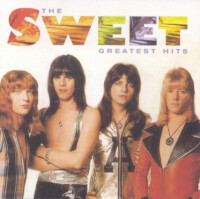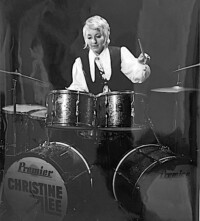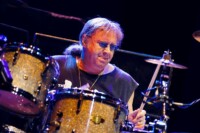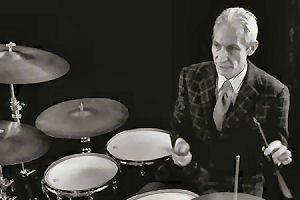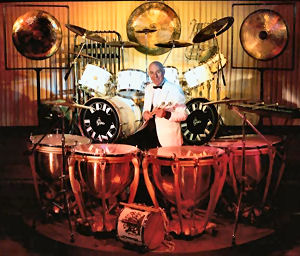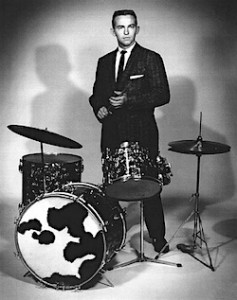 James Marcus Van Eaton was born in Memphis on December 23h, 1937 and about 20 years later was responsible for playing drums on a record which exploded onto the music world more than any other song had done up until then. The song in question was “Whole Lotta Shaking Going On” by Jerry Lee Lewis. It came out in 1957 and it shook up all the embryonic young wannabe musicians like myself who heard it to the core. It was music which was completely raw and Jerry Lee’s lyrics, whether we knew what he was singing about at the time or not, happened to be extremely raunchy. And, we loved it – warts and all.
James Marcus Van Eaton was born in Memphis on December 23h, 1937 and about 20 years later was responsible for playing drums on a record which exploded onto the music world more than any other song had done up until then. The song in question was “Whole Lotta Shaking Going On” by Jerry Lee Lewis. It came out in 1957 and it shook up all the embryonic young wannabe musicians like myself who heard it to the core. It was music which was completely raw and Jerry Lee’s lyrics, whether we knew what he was singing about at the time or not, happened to be extremely raunchy. And, we loved it – warts and all.
Listening to the words now, when we’d like to think we’re all men of the world, we don’t need to be educated as to what he’s singing about – it doesn’t leave much to the imagination. However I wouldn’t be surprised if they went over Jimmy Van Eaton’s head at the time – like they did mine and most of my contemporaries. I won’t retell them here but you’ll find them on line and there is no double entendre and they aren’t innocent. Jack Clement the recording engineer actually thought the record was too risqué to make it. Interestingly enough listening to Big Maybelle’s original version of the song, which was produced by Quincy Jones and well worth listening to, the lyrics are nothing like as raunchy as ‘The Killer’s’, unless there’s something I’m missing.
But none of this is what ‘Groovers and Shakers’ is about – we’re all about the bass, and the snare, and mostly about the drummer.
Jimmy Van Eaton is the drummer in question this time and he grew up in Memphis where even though there was a piano in his parent’s house he had a burning desire to play the drums. Like most of the others I’ve written about in Groovers and Shakers, he saved his pocket money earned from his paper round to buy them.
He began his musical career by playing trumpet in the 7th grade but by the time he’d reached the 9th grade (14 or 15 years old) he was playing drums and influenced by Gospel music and the Big Band drummers he heard in groups like ‘The Dukes of Dixieland’ from New Orleans. He liked Buddy Rich but admits he wasn’t quite so impressed with Gene Krupa. Van Eaton says he didn’t think Krupa was actually playing anything he couldn’t play. But the sort of music his heroes played certainly wasn’t what he was being taught in High School – he was being tutored in rudimental drumming and only that. Even though he was in Memphis, the birthplace of rock ‘n’ roll, his instructors weren’t interested in teaching anything other than marching drumming and the students weren’t being shown any other style of music. If they wanted to play anything different, they did it on their own!
Eventually he received a scholarship to Memphis University to study and this was where he formed his first band ‘The Jivin’ Five’ who played Dixieland music. They had a taste of success in a local talent competition but Dixieland music was fading as Elvis arrived on the scene so eventually he chose to play rock and roll even though as he says, he was certainly capable of playing jazz. However, as he tells us: “everything changed when drums and guitar collided!”
Like Elvis Presley he found his way to Sun records (or rather Memphis Recording Service as it was called) around 1956 to do a demonstration record with a band called The Echoes whereupon Sam Phillips and the engineer Jack Clement, liked what he was doing, (playing double-handed straight eights with a hint of a shuffle) so much he became in demand as the label’s house drummer. They called his rhythm ‘Herky Jerky’ and consequently his career blossomed musically, although not necessarily financially – he was being paid $42.50 a session as the first call drummer for Sun Records. In the fullness of time he played on well over half the records Sam Phillip’s company released.
There was another rhythm James Van Eaton favoured called ‘Choo, Choo Train’ which was a relentless straight eight beat he picked up from Charles Connor, who invented it when he stood next to a steam engine with Little Richard listening to the rhythm the pistons made and then emulating it. Little Richard wanted Connors to play this feel on all his fast tunes and it was frequently played against a shuffle from the other musicians. Clement described James Van Eaton’s playing as: “not fancy but intense, spirited and intricate. Every beat falls exactly where it needs to and does exactly what it needs to.”
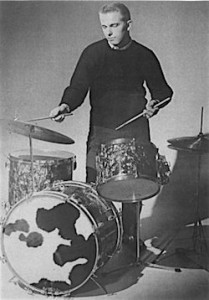 James Van Eaton’s first proper record was made at 706, Union Avenue playing with a guy called Billy Lee Riley who eventually had a rockabilly hit with a song called “My Gal is Red Hot” which is a much recorded song and beloved by aficionados of the genre. This was at a time during the ‘Cold War’ when America was paranoid about Hydrogen-bombs and fascinated by the possibility of aliens from outer space. Riley actually had a backing band with Jimmy called the ‘Little Green Men’ who wore heavy-weight green suits and made a record on their own with Jerry Lee on piano called “Flying Saucer rock ‘n’ roll”. Ultimately all the guys in the Little Green Men became the house band at the Sun studios.
James Van Eaton’s first proper record was made at 706, Union Avenue playing with a guy called Billy Lee Riley who eventually had a rockabilly hit with a song called “My Gal is Red Hot” which is a much recorded song and beloved by aficionados of the genre. This was at a time during the ‘Cold War’ when America was paranoid about Hydrogen-bombs and fascinated by the possibility of aliens from outer space. Riley actually had a backing band with Jimmy called the ‘Little Green Men’ who wore heavy-weight green suits and made a record on their own with Jerry Lee on piano called “Flying Saucer rock ‘n’ roll”. Ultimately all the guys in the Little Green Men became the house band at the Sun studios.
Believe it or not, it was just over sixty years ago when Jerry Lee Lewis came into the studio to make a record called “Crazy Arms” and Jimmy played on it with him – just piano and drums. However by the time they made “Whole Lotta Shaking” they had added a guy called Roland Janes on guitar. JM was doing gigs with Jerry Lee and they had been playing the song live in their shows and he tells a story about a single gig in Ferriday, Louisiana where they had five requests to play the song. This was evidently a good thing because they were playing for four hours and needed to play as many songs as they could remember. (For those who are interested there’s a road named for Jerry Lee Lewis in Ferriday.)
I said “warts and all“ and it’s safe to say that in those days there were lots of them in just about all of our favourite records, and often this was their charm and we would-be musicians would slavishly copy what now turn out to be mistakes. They were often present in music recorded in a single take and this was due to the often heard line in studios that time is money. Once I became experienced in working in the studios I discovered that, no matter how many takes you did, the first one always had a spirit the others didn’t! Jimmy is on record talking of this first take syndrome, saying that there was something magical, even spiritual about the studios at 706, Union Avenue which contributed to this.
Elvis Presley had a record out called “Let’s Have a Party” which was only 1 minute and 32 seconds long and the thing about his records was that the vocal was recorded at the same time as the backing track so, once his vocal was right that was the end of the session. Even if poor old Scotty Moore, Elvis’ long-time guitarist, hadn’t quite got his stuff together by then, the session was over.
As far as Whole Lotta Shakin was concerned, depending on whom you listen to, it was recorded very quickly. There’s one version which says there was only one take and another which claims there were two – recorded one after the other at slightly different tempos.
Jimmy played on 132 different songs at Sun Records before he moved on with his life. That’s him on Bill Justis’ instrumental “Raunchy” which for my money is up there with “Green Onions” as far as setting the scene for mainstream American music in the late fifties is concerned. He grew up with Conway Twitty in Memphis and played on several records with him although unfortunately I can’t tell you if he played on his big hit: “It’s Only Make Believe”. Since it’s one of my all-time favourites I’d like to think he did but because it was co-written with Conway by Jack Nance, who was also a drummer, I guess it’s unlikely.
But he certainly played on my favourite three Jerry Lee Lewis records: “Whole Lotta Shakin Goin’ on”, “Great Balls Of Fire”, “High School Confidential” and “Breathless”. OK make that four! [I’d like to say that it was James Van Eaton I heard in 1958 when I pressed my ear to the side door of the Regal Cinema in Edmonton when Jerry Lee was in the UK on the tour with ruined his career. Jerry Lee had just married Myra, a 13 year old who just happened to be his first cousin.
Now we talked about warts and all, and in the fifties we slavishly copied every beat and nuance of these evocative American songs, even things which now would appear to be obvious mistakes. For example: there’s some conflicting stop-break accents on High School Confidential, and even the great Whole Lotta Shakin has some very strange sections where JM stops playing the off- beat and eventually carries a triplet fill across a bar line, but this was part of the charm.
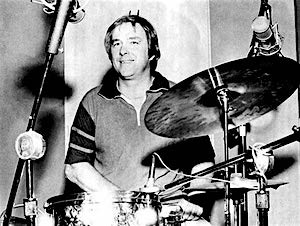 Recording anything at Sun Studios was not an exact science and drums were no exception. Jack Clement didn’t hold with headphones and wasn’t happy with bass drums because if one was being played it needed to share a channel with the bass. He also felt that a track should speed up as it progressed to keep it interesting and any musician who couldn’t do this was missing the point.
Recording anything at Sun Studios was not an exact science and drums were no exception. Jack Clement didn’t hold with headphones and wasn’t happy with bass drums because if one was being played it needed to share a channel with the bass. He also felt that a track should speed up as it progressed to keep it interesting and any musician who couldn’t do this was missing the point.
From a technical standpoint Evidently the studio’s board had just five microphone inputs and if possible the vocal needed its own channel , although it could share with the piano. As I said one mic. picked up the snare drum, hi hat and cymbals. Otherwise there was a microphone for the guitar. This unsophisticated recording system was not peculiar to Sun Records and often they would overdub mono to mono to mono to add more instrument, voices or effects to the tracks.
There were things that could be done to tame the sound of the drums, mostly so they didn’t ‘bleed’ onto the vocal track which would make what was arguably the most important element of the track, impossible to control. One of these seems innocuous and simply meant laying a pair of wire brushes on the snare drum to tame the impact noise down a little and dampen the sound when it was hit with a drumstick. It also created a mechanical reverberation because the brushes would bounce and create another, albeit softer repeat sound. It wasn’t at all controllable but it created an interesting effect, providing the brushes didn’t bounce off!
However the thing which entranced Levon Helm about the drumming on Whole Lotta Shaking was the fact that the snare drum was tuned down and a wooden cigar box was placed on the top head. JM Van Eaton played his off-beats and his fills directly on this box. According to Clement, toms were seldom even set-up in the studio because they weren’t needed or wanted in the music they were recording.
JM was only at the studios from 1956 to 1959 and in that time besides Jerry Lee Lewis he played with Johnny Cash (who didn’t really like drums and they certainly weren’t allowed at the Grand Old Opry in his heyday), Roy Orbison, Conway Twitty, Charlie Rich and a host of others like Dickey Lee, Jimmy Wages and many others – all very well known to Rockabilly fans.
As far as drum kits were concerned Jimmy had what appears to be a Gretsch set with a pony skin front head just like DJ Fontana’s and a Pearl. That blue glitter Ludwig set with the ‘400’ snare drum you see in all the photos of Sun Records, actually belonged to the studio.
Session musicians simply didn’t make much money from their contributions to important records and needed to be on the road at weekends playing live gigs to supplement their daily endeavours in the studio. As it happens Jimmy went off to make his fortune outside of drumming, firstly in vending machines then in ‘investment banking’ and at the same time he found God and lived happily ever after. With that change of occupation in mind he could also be featured in Dolbear’s ‘Something else for the weekend’ section…
Bob Henrit
August 2016

